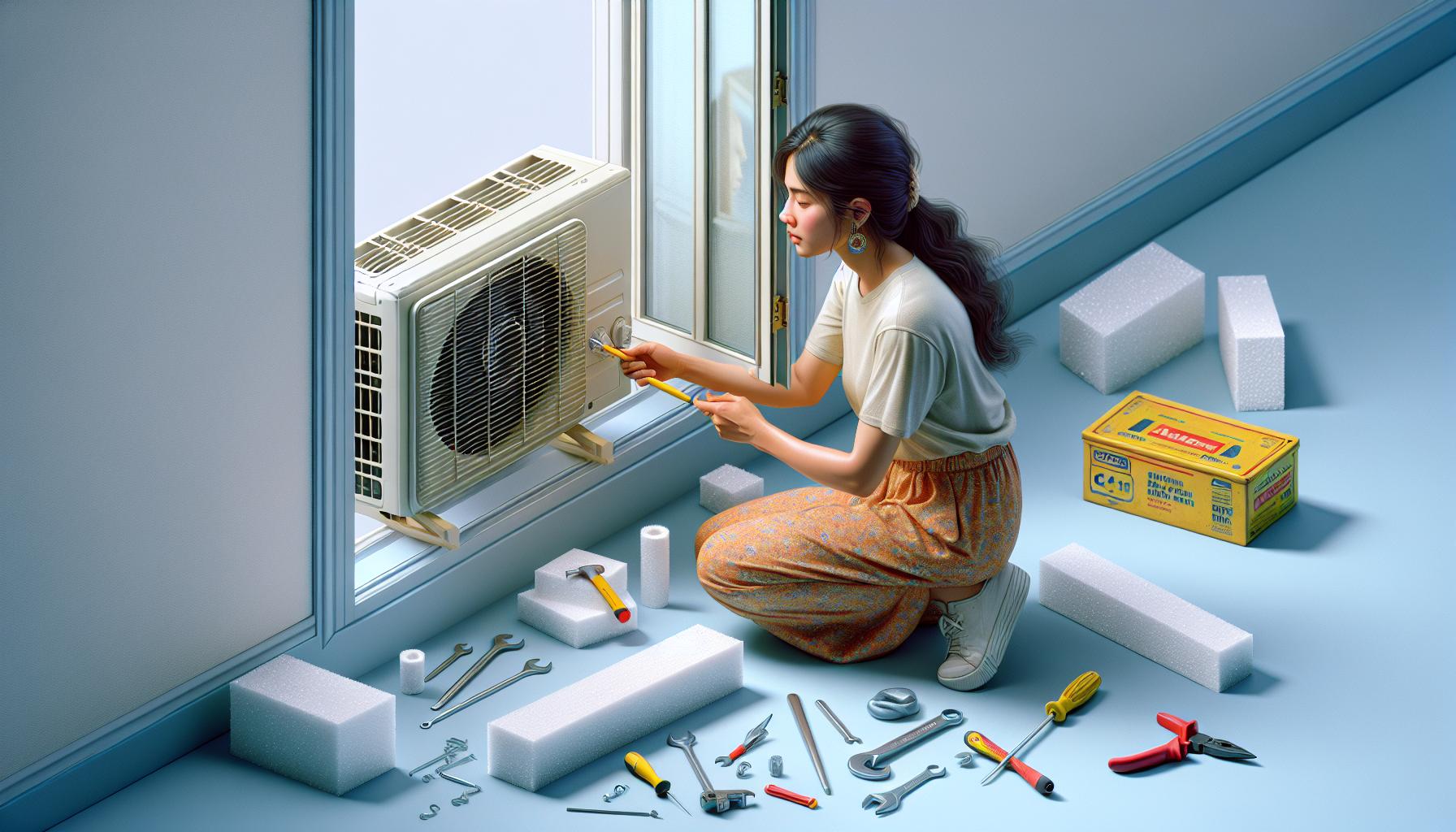Ready to beat the heat with a new window air conditioner? You’re in luck, because installing one can be a straightforward DIY project. With the right tools and a bit of know-how, you’ll be chilling in no time. Choosing the correct type of window is crucial for a smooth installation. Most units are designed for single or double-hung windows, but if you’ve got casement or sliding windows, you’ll need to think differently. Let’s jump into the steps to ensure your cool comfort is just an installation away.
Benefits of Installing an Air Conditioner on Window
Efficient Cooling
When you opt for a window air conditioner, you’re investing in a system that provides targeted cooling. These units offer an efficient way to cool down the room they’re installed in, rather than cooling the entire home, which is often unnecessary and inefficient. Unlike central systems, window air conditioners work by drawing in warm indoor air and passing it over an evaporator coil where the heat is absorbed by the refrigerant and expelled outside, resulting in a comfortable, cool environment.
Space-saving
A major benefit of window air conditioners is their compact design which saves space in your home. They’re an excellent choice for smaller living spaces or if you prefer to keep your floor space unobstructed. Since they mount directly into your window, they don’t take up any valuable real estate that could otherwise be used for furniture or other home decor.
Cost-effective
Installing a window air conditioning unit can be a highly cost-effective cooling solution. Not only are the units themselves typically less expensive than larger system installations, but the energy consumption is also lower. This is especially true if you only need to cool certain sections of your home, as opposed to the entire property. Also, units often feature energy-saving switches and programmable timers, contributing to lower utility bills. With the option to remove and store the unit after summer, you also reduce wear and tear, potentially prolonging the lifespan of your air conditioner.
Things to Consider Before Installing an Air Conditioner on Window

Window Size and Compatibility
Before you even think about hoisting a new air conditioning unit into your window frame, it’s essential to measure the dimensions of both the window and the AC unit. Double-hung or sliding windows typically offer the best compatibility with standard window air conditioners. Nevertheless, with a few adjustments, certain air conditioners can be installed in sliding windows as well. Ensure your window’s width and height align with the unit’s requirements for a secure fit.
- Confirm that the window sash can support the weight of the unit.
- The window should open sufficiently to allow the AC unit to fit.
- Check if extra support brackets or insulating foam will be needed.
Power Supply and Electrical Requirements
Your air conditioner’s efficiency and safety largely depend on the power supply and electrical infrastructure of your home. Window air conditioners generally require a stable and dedicated power supply to operate effectively. Using the same circuit for high-energy appliances and your AC can lead to electrical issues such as tripped breakers or blown fuses.
- Ensure the circuit can handle the unit’s amperage without overloading.
- Avoid using extension cords; instead, plug the unit directly into a power socket.
- If necessary, consider installing a new circuit exclusively for your air conditioner.
Installation Restrictions and Regulations
Awareness of installation restrictions and regulations is crucial in avoiding penalties or compromising safety. Installing your AC in a fire escape route or egress window could be a violation of fire safety codes. Also, some areas may have guidelines on the preservation of building aesthetics or noise control that could affect AC installation.
- Check local building codes and regulations about window AC installations.
- Be aware of regulations concerning noise levels and exterior alterations.
- Ensure your installation plan does not infringe on community rules or neighbourly considerations.
By paying close attention to these considerations, you’re setting yourself up for an installation process that is much more likely to go smoothly and without any unwanted surprises. Remember, the key to a successful installation lies in preparation and adherence to the guidelines at hand.
Steps to Install an Air Conditioner on Window

Gathering Tools and Materials
Before you begin the installation process, it’s imperative to have the right tools and materials at your disposal. You’ll need:
- Measuring tape: to measure the window dimensions
- Screwdriver: for securing the unit
- Level: to ensure the unit is properly balanced
- Air conditioner brackets and additional support: to provide the necessary stability
- Foam insulation: to seal any gaps and improve efficiency
Having these tools by your side ensures a smoother installation process and reduces the risk of interruptions.
Preparing the Window and Surroundings
Ensure that the window where you plan to install your air conditioner is repaired and in top condition. An unstable frame can jeopardize the installation, while a clean window ensures a snug fit. Clear any obstructions such as storm window frames or nearby branches. If your window is exposed to direct sunlight, consider choosing a different one to optimize your air conditioner’s efficiency. Clean the glass and mark the centre of the windowsill for accurate placement of the AC unit.
Mounting the Air Conditioner Unit
With the window prepped, carefully place the air conditioner in the window opening. Make certain that it’s centred and the bottom is resting securely against the sill. Extend the side panels to the window frame to eliminate any gaps on either side. The level comes into play here to confirm that the unit is not tilting either inward or outward, which could affect performance and drainage.
Securing the Unit and Sealing the Gaps
Safety first: Secure the air conditioner to the window using the provided brackets. An air conditioner that’s not anchored can be a hazard due to its hefty weight. Use foam insulation around the perimeter to fill any gaps, ensuring no air leaks. This not only improves cooling efficiency but also keeps critters and weather elements outside.
Testing and Troubleshooting the Air Conditioner
Once the unit is installed, it’s time to plug it in and test for proper operation. Make sure it turns on and starts to cool the room. Listen for any unusual sounds that could indicate a problem. If issues arise, refer to the manufacturer’s instructions for troubleshooting tips, or contact customer support for further guidance. By methodically following these steps, you can successfully install your window air conditioner and enjoy a cooler, more comfortable space.
Tips for Maintaining an Air Conditioner on Window

Regular Cleaning and Filter Replacement
A critical component of air conditioner maintenance is regular cleaning and filter replacement. Accumulated dirt and debris can drastically reduce your unit’s efficiency and if left unchecked, may lead to costly repairs. To ensure optimal functionality:
- Clean or replace the air filter monthly during the cooling season.
- Washing the condenser coils at the start of the cooling season can prevent any reduction in airflow.
- Regular cleaning mitigates the risk of the air conditioner freezing up, resulting in extended service life.
By simply replacing a clogged, dirty filter, you can lower your air conditioner’s energy consumption by 5% to 15%, according to the US Department of Energy.
Checking for Leaks and Condensation
Ensuring the integrity of the seals and the appropriate tilt of your air conditioner prevents water leaks and condensation issues that could damage your property. Be vigilant by:
- Inspecting the seals between the air conditioner and the window frame annually to confirm they’re intact and provide an effective barrier.
- Verifying the correct tilt of your air conditioner, usually no more than one-half inch as recommended by most manufacturers.
- Checking for water inside the drip pan and ensuring that condensation is draining properly to the outside.
Failure to monitor leaks and condensation can lead to moisture problems, which could potentially develop into mold or structural damage.
Monitoring Energy Consumption
Staying aware of your air conditioner’s energy consumption is beneficial for both environmental and economic reasons. Adopt these habits:
- Using a programmable thermostat or a smart plug to track electricity usage can offer insights into your unit’s efficiency.
- If the air conditioner continually trips circuit breakers or your electricity bill is unexpectedly high, this might indicate it’s time for maintenance or an upgrade.
- Consider energy-efficient models or units with a high Energy Efficiency Rating (EER) to save on costs in the long run.
By keeping an eye on how much power your air conditioner uses, you’ll not only save money but also contribute to reducing your carbon footprint.
Conclusion
You’ve now got the know-how to confidently install your air conditioner in a window. Remember, starting with the right tools and a clear workspace sets the stage for a smooth installation. By ensuring your unit is centred, level and securely fastened, you’ll be set for a cool, comfortable indoor experience. Don’t forget to seal those gaps to maximise efficiency and test the system to catch any hiccups early on. Regular maintenance, including cleaning and checking for leaks, will keep your air conditioner running optimally. With these steps, you’re not just installing an appliance; you’re investing in your comfort and the value of your home. Stay cool and enjoy the fruits of your labour!
